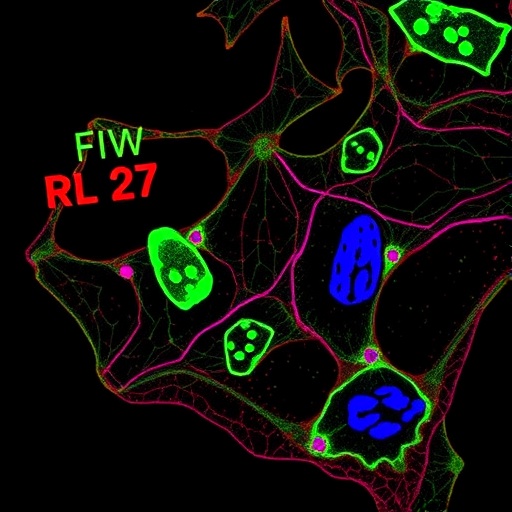
In the rapidly evolving landscape of cancer research, understanding the molecular intricacies that govern tumor metastasis remains a pivotal challenge. A recent correction published in Cell Death Discovery has shed new light on an intricate signaling axis implicated in the progression and metastasis of head and neck squamous cell carcinoma (HNSCC), a notoriously aggressive cancer subtype with poor clinical prognosis. The study revisits the role of a particular circular RNA, circRFWD3, elucidating its impact on cancer dissemination through a complex regulatory network involving microRNAs miR-27a/b and the nuclear receptor PPARγ.
Circular RNAs (circRNAs) are emerging as crucial post-transcriptional regulators with distinct properties compared to their linear counterparts, primarily due to their covalently closed loop structures that confer enhanced stability and resistance to exonucleases. The corrected findings underscore circRFWD3 as a significant modulator of HNSCC metastasis, operating through the intricate molecular axis of miR-27a/b and PPARγ. This sheds light on the noncoding RNA landscape, redefining how these exotic entities influence cancer cell behavior, particularly metastatic potential.
The study unravels a mechanistic cascade whereby circRFWD3 acts as a molecular sponge, sequestering miR-27a and miR-27b. These microRNAs are known to function as tumor suppressors by targeting several oncogenic pathways. By binding to and diminishing the functional availability of miR-27a/b, circRFWD3 indirectly leads to the upregulation of PPARγ, a nuclear receptor that governs gene expression linked to cellular differentiation, metabolism, and inflammatory responses. Importantly, in the context of HNSCC, PPARγ’s dysregulated expression facilitates a pro-metastatic cellular phenotype conducive to tumor invasion and migration.
.adsslot_epzD4JfXBa{width:728px !important;height:90px !important;}
@media(max-width:1199px){ .adsslot_epzD4JfXBa{width:468px !important;height:60px !important;}
}
@media(max-width:767px){ .adsslot_epzD4JfXBa{width:320px !important;height:50px !important;}
}
ADVERTISEMENT
HNSCC represents a heterogeneous group of malignancies originating from the mucosal linings of the oral cavity, pharynx, and larynx. Despite advances in surgical techniques, chemotherapy, and radiotherapy, metastatic spread remains a principal cause of therapeutic failure and mortality. The elucidation of circRFWD3’s role adds a compelling layer to the molecular narrative by pinpointing a noncoding RNA as a viable target for therapeutic intervention. Understanding this axis presents an unprecedented opportunity to design RNA-based therapeutics aimed at intercepting metastatic progression.
What makes circRNAs such as circRFWD3 particularly intriguing is their ability to regulate gene expression by competitive endogenous RNA (ceRNA) mechanisms, acting as ‘sponges’ that titrate microRNA activity. By effectively sequestering miR-27a/b, circRFWD3 dampens the suppressive effects these microRNAs exert over PPARγ mRNA translation. This fine balance of RNA-RNA interplay highlights a sophisticated regulatory network that transcends canonical transcriptional controls, illustrating the expanding complexity of the epigenomic landscape in cancer.
Further, PPARγ itself exhibits dualistic roles depending on cellular context. Known primarily as a master regulator of adipogenesis and metabolic homeostasis, in cancer biology, PPARγ’s function is paradoxical: it can act both as a tumor suppressor and a facilitator of tumor progression depending on tissue type and microenvironmental cues. In HNSCC, the overexpression of PPARγ driven by circRFWD3-mediated microRNA sponging accelerates epithelial-mesenchymal transition (EMT), a cellular reprogramming event critical for metastatic competence.
EMT confers plasticity to epithelial cancer cells, endowing them with mobility and invasiveness necessary for dissemination through the extracellular matrix and colonization at distant sites. The data support a model in which circRFWD3 indirectly escalates this phenotypic shift. This finding not only enriches our understanding of HNSCC pathobiology but also invites exploration of PPARγ as a pharmacological target in metastasis inhibition strategies.
On a translational level, the circRFWD3/miR-27a/b/PPARγ axis represents a promising biomarker axis for early detection and prognostic stratification of HNSCC patients. The stability and abundance of circRNAs in body fluids recommend them as feasible candidates for liquid biopsy assays, allowing for minimally invasive monitoring of tumor dynamics and treatment response over time.
The corrected article also emphasizes the therapeutic potential of targeting circRFWD3 through antisense oligonucleotides (ASOs) or CRISPR-based RNA editing technologies to restore the tumor-suppressive activity of miR-27a/b. By antagonizing circRFWD3, such approaches could downregulate PPARγ expression, mitigating metastatic spread and potentially augmenting the efficacy of existing therapeutic regimens.
Moreover, the interplay between circRFWD3 and the immune microenvironment warrants further investigation. PPARγ’s involvement in modulating inflammatory pathways suggests that circRFWD3-driven upregulation might influence tumor-associated macrophages and other immune components, thereby fostering an immunosuppressive niche that favors cancer progression.
Technological advances in high-throughput RNA sequencing and bioinformatics have been instrumental in identifying the circRFWD3 molecule and mapping its interaction network. These methods provide comprehensive views of RNA populations, enabling researchers to pinpoint noncoding RNAs with crucial functional roles while expanding the scope of cancer molecular biology beyond traditional protein-coding genes.
Importantly, this correction clarifies ambiguities in the original dataset and strengthens the reproducibility of the conclusions, reflecting rigorous scientific standards essential for translating these insights from bench to bedside. Such clarity accelerates the momentum to integrate circRNA-targeted modalities into the oncology therapeutic armamentarium.
In the broader context of RNA biology, findings implicating circRFWD3 in HNSCC metastasis contribute to a paradigm shift acknowledging the vast regulatory potential of noncoding RNA species. These insights underscore that the transcriptome’s noncoding fraction plays pivotal roles in oncogenic circuits and tumor-host interactions, opening avenues for novel diagnostics and therapies.
Future research directions might focus on dissecting the crosstalk between circRFWD3 and other miRNAs, long noncoding RNAs, and epigenetic modifiers within the tumor microenvironment. Such multi-layered regulatory webs could dictate cell fate decisions influencing tumor aggressiveness and therapeutic resistance.
In sum, the corrected study delivers compelling evidence that the circRFWD3/miR-27a/b/PPARγ signaling pathway is a critical mediator of HNSCC metastasis. The detailed mechanistic insights provided not only deepen our molecular understanding of cancer progression but also create a foundation for innovative RNA-centered therapeutic strategies that could transform clinical management and improve patient outcomes.
Subject of Research: Molecular mechanisms underlying head and neck squamous cell carcinoma (HNSCC) metastasis, focusing on the role of circular RNA circRFWD3 and its regulation of the miR-27a/b/PPARγ signaling axis.
Article Title: Correction: CircRFWD3 promotes HNSCC metastasis by modulating miR-27a/b/PPARγ signaling.
Article References:
Wei, Z., Wang, Y., Peng, J. et al. Correction: CircRFWD3 promotes HNSCC metastasis by modulating miR-27a/b/PPARγ signaling. Cell Death Discov. 11, 354 (2025). https://doi.org/10.1038/s41420-025-02547-0
Image Credits: AI Generated
Tags: cancer dissemination factorscircRFWD3 role in HNSCC metastasiscircular RNA in cancer researchhead and neck cancer progressionmiR-27a/b function in cancermolecular mechanisms of metastasisnoncoding RNA in oncologynovel therapeutic targets in HNSCConcogenic pathway targetingpost-transcriptional regulation in cancerPPARγ signaling in tumorstumor suppressor microRNAs





